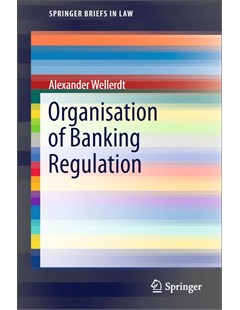Organisation of Banking Regulation
Cuốn sách này minh họa sự tương tác của các cơ quan quản lý ngân hàng và thảo luận với nó những thách thức liên quan đến các vấn đề pháp lý và kinh tế. Thứ nhất, tầm quan trọng của các tổ chức hành chính đối với việc thực hiện luật pháp quy định đối với các ngân hàng và tổ chức tài chính được thể hiện. Trên cơ sở này, năm mô hình tổ chức hành chính trong lĩnh vực quản lý ngân hàng đã được hình thành
2015
Bank regulation is a form of government regulation which subjects banks to certain requirements, restrictions and guidelines, designed to create market transparency between banking institutions and the individuals and corporations with whom they conduct business, among other things. As regulation focusing on key factors in the financial markets, it forms one of the three components of financial law, the other two being case law and self-regulating market practices.
Given the interconnectedness of the banking industry and the reliance that the national (and global) economy hold on banks, it is important for regulatory agencies to maintain control over the standardized practices of these institutions. Another relevant example for the interconnectedness is that the law of financial industries or financial law focuses on the financial (banking), capital, and insurance markets.Supporters of such regulation often base their arguments on the "too big to fail" notion. This holds that many financial institutions (particularly investment banks with a commercial arm) hold too much control over the economy to fail without enormous consequences.
This is the premise for government bailouts, in which government financial assistance is provided to banks or other financial institutions who appear to be on the brink of collapse. The belief is that without this aid, the crippled banks would not only become bankrupt, but would create rippling effects throughout the economy leading to systemic failure. Compliance with bank regulations is verified by personnel known as bank examiners.
This book illustrates the interaction of banking regulators and discusses with it the challenges associated with legal and economic issues. First, the importance of administrative organizations for the implementation of regulatory laws for banks and financial institutions is demonstrated. On this basis, five administrative organizational models in the field of banking management were formed. Thereby, banking regulators can be classified according to their influence on regulatory decisions. Their influence extends from preparation through enforcement to controlling regulatory decisions. In particular, the European Central Bank's cooperation with national banking regulators is analyzed. Finally, the main legal and economic arguments of the Banking Regulations in the Economic and Monetary Union are discussed.
The book includes:
Alexander Wellerdt, Organisation of Banking Regulation, Springer, 2015.
 |  |  |
| Organisation of Banking Regulation | Risk Management and Financial Institutions | Operational risk management best practices in the financial services industry |

Thứ Năm, 17:53 17/06/2021
Copyright © 2018 Hanoi University of Industry.